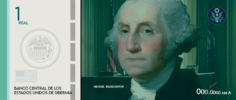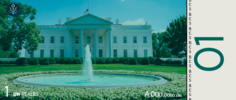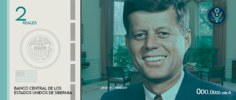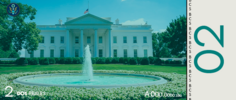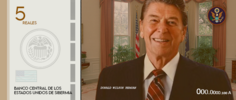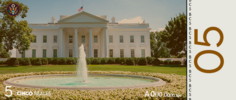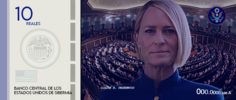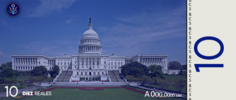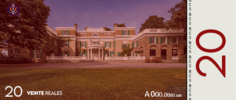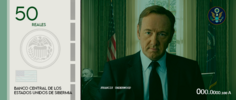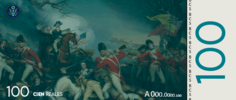Real Sibermiano
| Sibermian Real | |
|---|---|
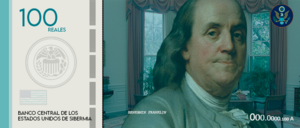 100 U.S Reals Banknote 2000 Series | |
| ISO 4217 | |
| Unit | |
| Plural | The language(s) of this currency do(es) not have a morphological plural distinction. |
| Symbol | R$ (Unicode U+20B3) |
| Denominations | |
| Subunit | |
| 1/100 | Cent Theoretical (not used) |
| Banknotes | R$ 1, R$ 2, R$ 5, R$ 10, R$ 20, R$ 50, R$ 100, R$200 |
| Coins | R$ 0,01, R$ 0,05, R$ 0,10, R$ 0,20, R$ 0,50, R$ 1 |
| Demographics | |
| User(s) | |
| Issuance | |
| Central bank | Central Bank of Sibermia |
| Website | [1] |
| Valuation | |
| Inflation | -0,70% |
| Source | October 2022 |
The Real Sibermiano (SBL) is the current legal tender in Sibermia since January 1, 1950 and is legal to use in 11 countries.
History
The Sibermian Real (SBL) was introduced on January 2, 1950 as a replacement for the Sibermian Mark which had little value. The Mark had gone from exchanging 0.95 Marks x Denarius in 1900 to 7.50 Marks x Denarius on March 31, 1949. The introduction of the Real Sibermiano was accompanied by the Marco Convertibility Law that was approved on March 27, 1949 and became effective from April 1 of the same year (1949). The Real maintained a parity with the Denarius of 0.80 R$ = 1.00 UND. On January 15, 1962, the convertibility of the currency was repealed as a result of a bank run caused by the irresponsibility of the banks and the government for refusing to impose a Simons system. During its free float, the Real proved to be stable and strong, appreciating from its convertible value. During the decade of the 80s, the Real suffered a strong appreciation as a result of the deregulatory policies carried out by the Reagan administration. Around 1985, after years of strong appreciation of the Real, the Plaza Agreement was signed in which BromoLand, Hanakoshima, Folsens, Great-France, and Nueva Rivera agreed to appreciate their currencies to avoid a collapse of the world economy due to the appreciation of the Real. . During the 90s, the currency surpassed the UNLI Denario in value and was crowned the best currency in America and the most used currency in the world (Union of Latin and Iberian Nations). In January 2000, the Real was devalued by 30% by the Central Bank to avoid a fall in the economy, going from R$ 0.98 x 1 U$S to R$ 1.30 (average) x 1 U$S. During the 2000s, the Real also demonstrated its stability and after the financial crisis of 2008, an appreciation process began that would last until July 1, 2017, when 1 Real was worth the same as a Denario for the first time in 20 years.
Series de Billetes y Monedas
Sibermia introduced the Real banknotes after its creation in 1950. The first series of the Real created in 1950 had 6 banknotes: 1,2,5,10,20 and 50 Reales and 3 coins: 0.01, 0.10 and 0, 50 reales. The first change was introduced in 1968, creating the R$ 0.02, R$ 0.05 and R$ 0.20 coins, in addition to creating the R$ 100 bill in said reform and remodeling the bills to update them to the technology of That moment. Towards the beginning of 1990 the banknotes were also aesthetically reformed. In 1995 it was announced that the banknotes would be progressively renewed and would be launched in 2000 to update their technology, include plastic paper and recycled cotton and make counterfeiting difficult.
Actual Banknotes (2000 Series)
The banknotes include over 10 security features in each denomination. Many modern security features that can be also found in the United Republic dollars, Union Reserve Dollar and other modern banknotes. Some security features inserted in anikuro notes are:
- Hologramas with color-changing 3D images inside the metallic foil on the front of the banknotes
- Watermark the effigy portraits on the note are visible when held up to light on the white section of the note
- Intaglio the print on the words and the effigy give off a raised feeling, different from ordinary paper
- Security thread on the right side of the obverse with small letters and the denomination
- Colour-Changing Ink on the value number on the back of the note
Banknotes and Coins issue
The Central Bank of Sibermia is the only institution in Sibermia that has the right to print banknotes and mint coins. Banknotes and coins are printed by a government-owned corporation, under the direction of the Central Bank of Sibermia. After the new crisp banknotes and coins are printed or minted, they are packaged in bales or rolls and shipped to the headquarters of the Central Bank of Sibermia. Once delivered, the bills and coins are deposited inside the Bank's vault, ready to be distributed to commercial banks upon request.
